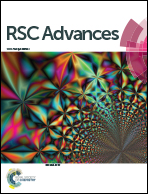Exterior and small carbide particle promoted platinum electrocatalyst for efficient methanol oxidation
Abstract
Carbides have a synergistic effect on noble metal based electrocatalysts. However, carbides usually have large particles or are wrapped in an inert carbon block, which greatly reduces their interaction with other loaded functional particles. Typically in this paper, we report the synthesis of tungsten carbide particles with a diameter of no more than 10 nm on the exterior surface of carbon spheres (denoted as WC-on-CS) with the help of surfactant as dispersant. Pt particles are then loaded on the material to form a Pt/WC-on-CS electrocatalyst. The above materials are characterized by XRD, SEM, TEM and electrochemical measurements. The results indicate that the exterior and small WC particles have a much higher promotion effect on the Pt electrocatalyst than carbon-wrapped WC particles for methanol oxidation reaction (MOR). The exterior and small WC particles have more exposed surfaces and closer contact with the loaded Pt particles, leading to excellent MOR activity and stability.


 Please wait while we load your content...
Please wait while we load your content...